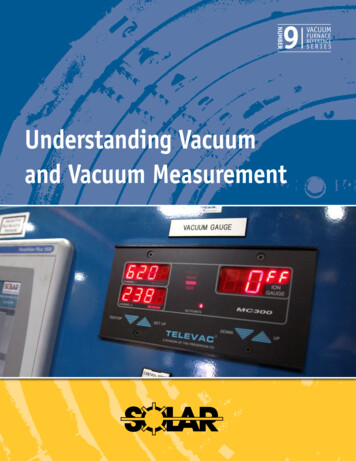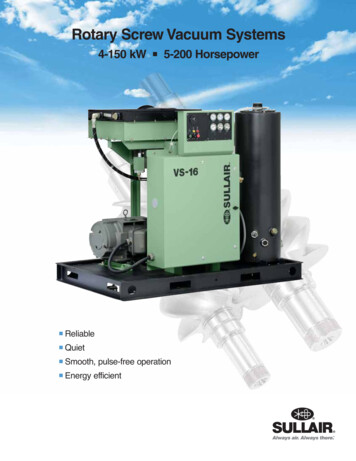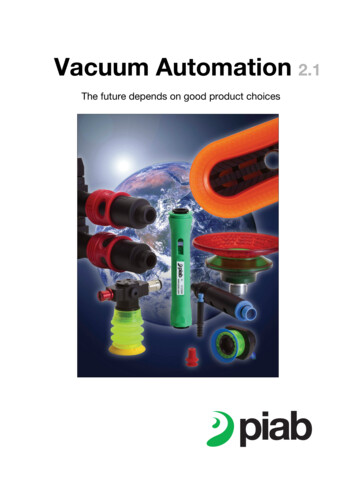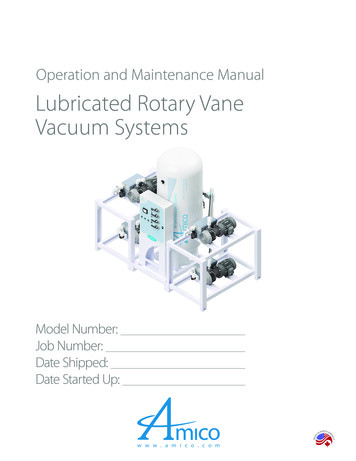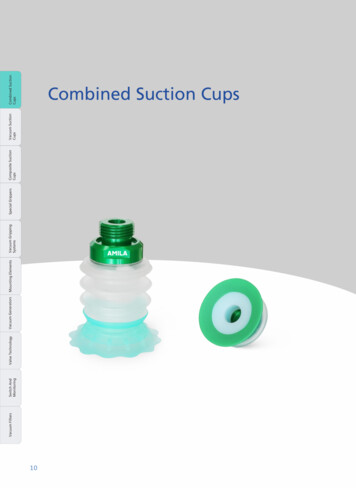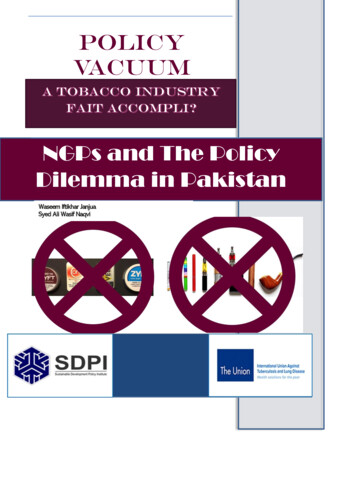
Transcription
PolicyVacuumNGPs and The PolicyDilemma in PakistanWaseem Iftikhar JanjuaSyed Ali Wasif Naqvi
ContentsAcronyms . 3About the Project . 4NGPs and Policy Dilemma in Pakistan . 5Introduction . 5Understanding the NGPs . 6Policy Gaps and Vacuum in Pakistan . 8Exploitation by the TI . 9Recommendations & Conclusion . 11
AcronymsANDS:Alternative Nicotine Delivery Systems1ENDS:Electronic Nicotine Delivery SystemsENNDS:Electronic Non-Nicotine Delivery systemsFCTC:Framework Convention on Tobacco Control.HnB:Heat no Burn.HTPs:Heated Tobacco Products.GoP:Government of Pakistan.LMICs:Low-and-Middle-Income Countries.MoNHSR&C:Ministry of National Health Services Regulation andCoordination.MPOWER: (Six components of World Health Organization, these are themeasures complementing Framework Convention on TobaccoControl). M refers to Monitoring the tobacco use and preventionpolicies pertaining to the tobacco usage, P is to ‘Protect’ thepeople from harmful tobacco smoke. Similarly, O refers to‘Offering’ the help to quit smoking, Warning about the harmfuldangers of the tobacco use is the next component. ‘E’ has beencatered to ‘Enforce’ the ban on the tobacco advertising,including promotion and sponsorship of events etc. and finally‘R’ refers to ‘Raising’ the taxes on all tobacco products.MRTPs:Modified Risk Tobacco Products.NGPs:Next Generation Products.PREPs:Potentially Reduced-Exposure ProductsSRO:Statutory Regulatory OrderTCC:Tobacco Control Cell.TI:Tobacco Industry.WHO:World Health Organization.1Currently five ANDS are available in the market gum, patch, nasal spray, oral inhaler, and sublingual tablets.
About the ProjectSustainable Development Policy Institute (SDPI), through Bloomberg Tobacco ControlInitiative and in collaboration with The Union is conducting tobacco control project inPakistan. The project objectivises to assist the Ministry of National Health in developingPakistan’s strategic policy direction and guideline on GHW/PHW, Smokeless TobaccoControl (SLTC), and Next Generation Products (NGPs) including E-cigarettes, ENDS,ENNDS, ANDS and HnBs. The project also looks forward to collating the evidence ongaps in existing TC framework in line with MPWER commitments by Pakistan. Finally, theproject will also facilitate the national and provincial governments in sustainable TCinitiatives through system strengthening and capacity building of the stakeholders, inpost-COVID-19 environment. This policy brief develops an understanding of the rapidlyexpanding NGPs market, and foresees it mushrooming out of control before a realizationat the national policy level takes the charge. Foregoing in view, this policy brief aspiresto highlight the significance of the policy development on the tobacco products andmakes policy recommendations for banning the NGPs in Pakistan. In is also an effort tostrengthening the need for a multi-sectoral and comprehensive tobacco control regimeand policies in Pakistan, the recommendations will be shared with the policy makers andlegislative framework.4
NGPs and Policy Dilemma in PakistanIntroductionHealth systems around the globe are traditionally structured at national level and thepolicies disseminated to the lower tiers. After the institution of the 18th ConstitutionalAmendment, multiple governance sectors, including health, were devolved to theprovinces. However, many structural impediments continued to hinder the uninterruptedfunctioning at provincial level, not to mention issues causing inevitable temporaryreversal to federal level (Khan et al., 2014). Nishtar (2011) has argued in favour ofretaining health-related policy and governance issues at the national level. Tobaccocontrol is a vital issue, notwithstanding the politics of tobacco, the policy needs to accruefrom the MoNHSR&C for further dissemination and implementation. Due to structuralinadequacies, devolution of power, political reluctance, and many other inhibitions, thetobacco control policies get delayed, and in most cases are absent, becoming a majordriver of health inequalities. Tobacco Industry (TI) finds the appropriacy in policy vacuumand exploits these gaps very conveniently (Janjua and Naqvi, 2020).Tobacco continues to be the leading cause of the preventable deaths and causesenormous health burden on especially in Low-and-Middle-Income-Countries (LMICs),which, Rezaei et al. (2016) contend, has been estimated to be as high as 15% of thehealth budget in some countries. The tobacco control policies rest on two significantpillars; first, preventing the initiation of smoking, and second, smoking cessation. Thefocus of national policies in Pakistan has been on the former, with minimal to no policiesfocusing on the latter. There is a constant struggle between the tobacco control regimeon the one hand and tobacco industry exploiting all possible gaps on the other. Realizingthe policy vacuum in the cessation domain, TI is seamlessly indoctrinating theyouth/smokers and is introducing Next Generation Products (NGPs) as a “alternative” or5
“harm reduction” aid making hefty profits at the cost of the health (Hatsukami and Carroll,2020).The policy vacuum in NGPs is confounding those who are in genuine need of help to quit,as well as encouraging the TI to make rapid progress and profits in a short span of time.Foregoing, this policy brief inquires the issues related to policy gaps, makingrecommendations to overcome the vacuum, emphasizing the need to promote proactiveand protective regulation and legislation rather than curative and preventive policies.Understanding the NGPsThe US Institute of Medicine referred to the products with reduction in exposure to oneor more tobacco toxicants as “potentially reduced-exposure products” or PREPs (Strattonet al., 2001), which was replaced by the Food and Drugs Administration as the “modifiedrisk-tobacco products (MRTPs). The Union (2020) hasdefined ENDS, HTPs, Novel, Alternative, Emerging andNGPs as the hybrid products that contain both tobaccoand nicotine solutions, and their rapid emergence hasblurred the difference among the tobacco products. Forexample, Electronic Nicotine Delivery Systems (ENDS) isthe umbrella term used for the electronic smoking products and includes e-cigarettes,vapes, vape pens, etc.(Iftikhar and Naqvi, 2019-2020) ENDS are the devices that heatthe liquid containing nicotine to create an inhalable aerosol. The products vary in shape,size, function, and price, ranging between low-cost disposable devices to large refillabletanks. E-Cigarettes also vary with regard to nicotine dosage, flavours, emissions, design,battery voltage, and unit circuitry (Margham et al., 2016, Talih et al., 2014). Additionally,the open systems in E-Cigarettes contain a refillable tank whereas the closed systems are6
either disposable or a prefilled cartridges can be added to such devices.(Chen et al.,2016) Juul, Vype and Blu are some of the examples.Similarly, as per WHO (2020), the Heated Tobacco Products (HTPs) or Heat-no-Burn (HnB)products use a device to heat the tobacco and other chemicals to produce the aerosol.They have been available in the market since 1980. These are the specially designedcigarette-pods or plugs such as ‘heat sticks’ or ‘neo sticks’, which are designed to heatthe tobacco to 250 to 300 degrees Celsius (compared to the conventional cigaretteburning at 900 degrees), besides producing many toxicants(Bitzer et al., 2020).2 LilHybrid (Korean tobacco & Ginseng Corporation), Ploom Tech (Japan TobaccoInternational, Glo iFuse (British American Tobacco) are some of the examples of thesehybrid products. Similarly, Velo, Lyft, Dryft, Zyn, Paz, ZoneX, On!, and Spirit etc. are thechewable non-nicotine and nicotine pouches falling in the NGP categories. The containerholds small bite-size pouches which can be placed in the mouth just like the snus orchewing tobacco.As mentioned above, most of the LMICs continue to focus on the prevention of smokinginitiation, albeit with little success. For example in Pakistan more than one thousandchildren between the ages to 6 to 15 yearsstart smoking every day (Ahmed et al.,2008). Very little efforts are underway tohelp cessation, establishment of cessationhelpline at the MoNHSR&C (TSFC, 2019),one such case in point. TI in Pakistan has along history of identifying regulatory snags, diverting public attention away from coreissues and profiting out of every opportunity.2Toxicants are produced in all combustible as well as non-combustible/chewing tobacco products.7
Policy Gaps and Vacuum in PakistanPakistan has been a signatory to the WHO FCTC for the past almost 17 years. The reportby WHO claims that at least one of the MPOWER policies is preventing almost 5 billion.To meet the MPOWER policies Pakistan has comprehensive set of laws and regulationsin place. However, enforcement has been a challenge in Pakistan (See, for example Janjua,2019, Janjua and Naqvi, 2019, Janjua and Naqvi, 2020, Naqvi and Janjua, 2019, Iftikharand Naqvi, 2019-2020). Moreover, almost all of the policies have exclusively focused onthe combustible manufactured cigarettes. Smokeless tobacco products (such asnaswar/snuss/Gutka etc.) and more prominently the NGPs have been completely absentfrom the policy. Local as well as global scholarship, and FCTC points to the need forenactment of regulatory actions controlling smokeless tobacco products (See, forexample, Khan et al., 2017, Siddiqi et al., 2016, Savitz et al., 2006, Mehrotra et al.,2019). The first decision regarding the NGPs was taken by the conference of parties ofthe FCTC during 2018, which differentiated the cigarette sticks from the HnB/HTPsdevices (Gruszczynski and Melillo, 2020). Literature pivots this distinction on the coreconcept of FCTC, which is the complete elimination of tobacco and smoking pandemic.HnBs and many other vaping products, smokeless tobacco products, etc. have since longbeen promoted by the TI as the MRTPs and PREPs which cause less harm – and thereforepromoted to the customers as safer alternative, despite no clear scientific evidence tosupport these claims. Instead of saving the smokers from harmful effects and preventingthe young children (and adults) from initiating smoking, these products continue to gainpopularity as “recued risk products”. Moreover, as highlighted by Gruszczynski andMelillo (2020), dichotomy was created by the FCTC in defining waterpipes as well, inwhich the waterpipe, per se has been referred to as “apparatus”, therefore delinking itfrom the tobacco products used in the waterpipe. This segregation provided the policygap at the point of sale, where the apparatus could be promoted and sold in8
flashy/golden colours and designs, while restrictions were to apply only on the tobaccoproducts. Turkey has been applauded to became the first country whose labelling lawsexplicitly requires the health warning to be placed on the waterpipe, hookah bottles andwaterpipes tobacco packages (See, for example Lempert and Glantz, 2018, Jawad et al.,2015).In Pakistan the policy vacuum and gaps (in existing policy) is complicating the situationand the preventive environment is becoming hazier because of the inclusion of the“economic factor” in the NGPs. As per the 2021-22 budget announced by thegovernment of Pakistan, Federal Excise Duty (FED) has been enhanced from 65% to100% for all imported tobacco products (News, 2020). Ironically the E-Cigarettes/Vapeproducts have been added to this list, making them legal to be imported. However, thelegal Vendors’ license and other requirements are not very well pronounced nor beingimplemented. Consequently, a mushrooming of Vape Stores and Hubs in the twin citiesof Rawalpindi and Islamabad, besides other provincial capitals and major towns, is anatural outcome.Exploitation by the TIThe dwindling cigarettes sales across the globe and understanding of ill-effects ofsmoking exacerbating COVID-19 have caused serious drop in sales and profits (Münzelet al., 2020). Despite the known and scientifically proven health detriments, and noknown benefits of the NGPs, TI has been running promotional events, campaigns, paidadvertisements, and social media advocacies to attract youth, reassuring health benefitsof these products during COVID-19 pandemic (Ramamurthi et al., 2020). The Bureau ofInvestigative Journalism in a study claimed that TI has specifically been targeting theyouth (Chapman, 2021a). Relatedly, the countries where the enforcement is weakest havebeen the easiest targets of TI, and the two countries topping the list in this regard are9
Kenya and Pakistan (Davies and Chapman, 2021). The advertisements on the socialmedia, YouTube channels, Instagram and Facebook have received estimated 1 Billionfunding campaign to run the ads promoting British American Tobacco products Velo andLyft (Davies and Chapman, 2021).It is important to note that with an ongoing project Tobacco Smoke Free Cities, theMinistry of National Health issued an SRO 72(1)/2020 on 30th Jan 2020, banning allonline advertising of the tobacco products and point of sale advertising and display ofthe tobacco products (GoP, 2020). As per WHO (2017), almost all of the NGPs includingE-cigarettes and nicotine pouches are extracted from tobacco and are injurious to lungs,dangerous to health and need to be regulated. Defying the SRO 72(1)/2020, and floutingthe laws of the land, British American Tobacco Company is busy polluting the minds ofthe youth in Pakistan, being a soft, unmonitored and under-enforced tobacco market(Chapman, 2021a, Davies and Chapman, 2021). To curb similar tactics, very recentlyUSFDA ordered four major TI manufacturers to share their online/social mediaadvertisement practices (Hunt, 2021). British American Tobacco has been operating inPakistan for decades and has been flouting the laws for an equal duration. Hiring of thesocial media influencers, producing scores of YouTube videos3, promoting their nicotinepouch products, and other NGPs, has facilitated flooding of the market due to youthattraction and affordability. Chapman (2021a) argues that the main aim of the campaignhas been to present these products as “cool” and have been presented in “glossy youthfocused advertising campaign”. Moreover, social media influencers have been paidheavily to promote these products on Instagram. Facebook and Instagram bannedpromoting NGPs (E-Cigarettes, nicotine pouches and HTPs/HnBs etc.), and weapons3British American Tobacco also launched Velo Sound Station, promoting their product through the youthsinging and enjoying Velo pouches, can be viewed at c-fKA.10
through influencers since 2019 (Graham, 2019). TI, however, continues to flout theinternational as well as local/national regulations in Pakistan.TI is also sponsoring music and sports events, including F1 e-sports tournament that wasstreamed live on the YouTube and was easily accessible to the children to watch not tomention the youth (Chapman, 2021a). The TI distributed international free samples ofNGPs to the Pakistani youth and children, attracting smokers and non-smokers alike(Chapman, 2021b).International TI is generally targeted for flouting the domestic laws, as they generally donot make such ingresses in the Western and their home countries. However, the domestictobacco industry is no less defiant of the laws. In one such widely covered event, at thehight of the COVID-19, a local Senator manufactured cigarettes and labelled the product“Senate House”. The packings were designed without any GHW/PHW, (ironically)containing the “Government of Pakistan” emblem on the top and Senate House writtenbelow. The free samples were distributed among the members of parliament in the statelodges (Haider, 2020). This act alone broke scores of domestic laws as well internationalobligations – however the event went unnoticed as far the regulatory and policy circlesare concerned.Such disturbing situation needs immediate and stern policy intervention, not only tocontrol the spread of the tobacco products, but to limit and end the import and ingressof NGPs. Some recommendations are being made here for consideration by the relevantstakeholders and policy circles, which will help Pakistan meet the national andinternational obligations in tobacco control regime.Recommendations & ConclusionAs mentioned above, many tobacco control policies have been reactionary, and theimplementation is lagging. TI is taking full advantage of the situation and continues to11
make ingresses, flout laws, and make violations with impunity. Although tobacco controlhas been progressing with enormous efforts from the MNHSR&C and civil society withsupport from international partners such as Bloomberg Philanthropies and The Union etc.there is serious policy voids as far as the NGPs is concerned. TI continues to exploit thegaps in existing policies. For such an effort tobacco control regime needs to support abroad-based multi-sectoral policy which could ensure regulation of all tobacco products,and possible banning of NGPs, putting an end to the rampant expansion and youthaddiction. Following recommendations are, therefore, bring made:1. The final goal of the tobacco control efforts is complete ban on all tobaccoproducts and NGPs, however, TI continues to exploit the gaps in existing policiesand the policy vacuum. There is an urgent need to plug these gaps and developa comprehensive multi-sectoral policy. NGPs need special focus in the policy torestrict and prohibit the rapid ingress in society.2. Youth and children have always been the focus of the TI promotion campaigns,argue Iftikhar and Naqvi (2019-2020). To replace aging and dead customers, TIcontinues to tactfully recruit youth, who would continue to buy the tobaccoproducts for many decades from now. In Pakistan there is an urgent need to startmass media and social media campaigns to discredit TI narratives and attractivecampaigns. It is important for Pakistan to have healthy youth to increase economicproductivity, and this is possible by preventing youth from becoming easy prey toTI. Moreover, simultaneously the TI continues to target the poor, uneducated andmarginalized groups in the rural areas through its traditional tobacco products. TIactivities and promotion tactics in rural and far-flung areas are also needs to bemonitored carefully.3. NGPs also tend to be promoted by the TI as the replacement therapy. Nicotinecraving is considered as a critical factor in quitting, albeit with no clear scientific12
evidence (cf DiFranza and Wellman, 2005, Kozlowski and Wilkinson, 1987).However, these studies increasingly reported, the nicotine replacement users tendto become dual (tobacco as well as nicotine replacement) addicts (Czoli et al.,2017, Sweeney et al., 2001, Alberg et al., 2005). There is a requirement to keepthis aspect in mind during admittance policy formulation.4. TI has been innovative to add popular flavours in NGPs to make them moreappealing for the youth and new starters (Hoffman et al., 2016). Flavours act as“silent aspect of tobacco marketing” (Camenga et al., 2018) motivating andpromoting agents. Ban on flavours has been scientifically observed to have apositive impact on reduction in smoking (Courtemanche et al., 2017). This aspectneeds special attention in the policy formulation process, as similar issues alsoexisted, but ban (for example, on sheesha products) worked very well in the past.Pakistan must consider outright banning the NGPs from the market.5. The permission to import cigars or other NGPs has economic implications andneeds serious policy regulation beyond the import duty imposed by thegovernment. TI and the importers have clearly demonstrated the import of tobaccoproducts and other NGPs rampantly. As mentioned above as well, the enforcementis weak link in tobacco control regime. There is an urgent need to strengthen theregulatory efforts targeting the import of all tobacco products and NGPs toprevent the youth addiction and rapid flooding of the market with theseunregulated products.6. Despite existing ban on advertising, British American Tobacco has been recruitingsocial media influencers and running YouTube channels to promote their products.Immediate and comprehensive ban is necessary to prevent promotion andmarketing of NGPs, should we hope to prevent our youth from addiction to theseproducts.13
7. Article 12 of the FCTC necessitates public awareness and communication throughmultiple channels to educate the masses (WHO, 2004). Policy formulation alwaysfocuses on promoting laws which have positive health outcomes. For example, inthe Western countries the stringent laws prevent the TI a freedom of operation ascompared to the LMICs (Doku, 2010). Policy formulation must focus on thedomestic health and prioritize well-being.Although the tobacco control laws exist, but with the ingress of NGPs and the speed withwhich these have been promoted and marketed to the youth is worrying, necessitatingan urgency in policy development. This paper has highlighted the issue of NGPs inabsence of the regulatory policies and argued that these products continue to endangerthe health of our youth through nicotine addiction. E-cigarettes and other NGPs attractthe youth who may otherwise not smoke regular cigarettes. Singh et al. (2020) positedthat between 2017 and 2018, past 30-day use of nicotine e-cigarettes among highschool seniors nearly doubled, from 11% to 21%, which is the largest recorded increasefor any adolescent use in more than four decades in the USA. No research has been doneon this issue in Pakistan, however, the likely trend will be revealing for many health andtobacco policy advocates.14
ReferencesAHMED, R., RIZWAN UR, R., MCDONALD, P. & AHMED, S. 2008. Prevalence of cigarette smoking amongyoung adults in Pakistan. JPMA. The Journal of the Pakistan Medical Association, 58, 597-601.ALBERG, A. J., PATNAIK, J. L., MAY, J. W., HOFFMAN, S. C., GITCHELL, J., COMSTOCK, G. W. & HELZLSOUER,K. J. 2005. Nicotine Replacement Therapy Use Among a Cohort of Smokers. Journal of AddictiveDiseases, 24, 101-113.BITZER, Z. T., GOEL, R., TRUSHIN, N., MUSCAT, J. & RICHIE, J. P. 2020. Free Radical Production andCharacterization of Heat-Not-Burn Cigarettes in Comparison to Conventional and ElectronicCigarettes. Chemical Research in Toxicology, 33, 1882-1887.CAMENGA, D. R., FIELLIN, L. E., PENDERGRASS, T., MILLER, E., PENTZ, M. A. & HIEFTJE, K. 2018.Adolescents' perceptions of flavored tobacco products, including E-cigarettes: A qualitative studyto inform FDA tobacco education efforts through videogames. Addictive Behaviors, 82, 189-194.CHAPMAN, M. 2021a. New products, old tricks? Concerns big tobacco is targeting youngsters tobacco-is-targeting-youngsters [Accessed Mar 1 2021].CHAPMAN, M. 2021b. Tobacco company selling nicotine to Pakistani youngsters. The News, Feb 21.CHEN, C., ZHUANG, Y.-L. & ZHU, S.-H. 2016. E-Cigarette Design Preference and Smoking Cessation: A U.S.Population Study. American Journal of Preventive Medicine, 51, 356-363.COURTEMANCHE, C. J., PALMER, M. K. & PESKO, M. F. 2017. Influence of the Flavored Cigarette Ban onAdolescent Tobacco Use. American Journal of Preventive Medicine, 52, e139-e146.CZOLI, C. D., FONG, G. T., MAYS, D. & HAMMOND, D. 2017. How do consumers perceive differences inrisk across nicotine products? A review of relative risk perceptions across smokeless tobacco, ecigarettes, nicotine replacement therapy and combustible cigarettes. 26, e49-e58.DAVIES, R. & CHAPMAN, M. 2021. Tobacco giant bets 1bn on influencers to boost 'more lung-friendly'sales. The Guardian, Feb 20.DIFRANZA, J. R. & WELLMAN, R. 2005. A sensitization—homeostasis model of nicotine craving, withdrawal,and tolerance: integrating the clinical and basic science literature. Nicotine Tobacco Research, 7,9-26.DOKU, D. 2010. The tobacco industry tactics-a challenge for tobacco control in low and middle incomecountries. African health sciences, 10, 201-203.GOP. 2020. SRO on Banning POS/TAPS [Online]. Islamabad: Ministry of National Health Services Regulationand Coordination. Available: http://www.tcc.gov.pk/downloads/SRO.72(I) 2020.pdf [AccessedMar 24 2021].GRAHAM, M. 2019. Instagram bans influencers from getting paid to promote vaping and guns [Online].USA: CNBC. Available: nfluencers-frompromoting-vaping-andguns.html#: :text ds%20on%20either%20platform. [Accessed Mar 31 2021].GRUSZCZYNSKI, L. & MELILLO, M. 2020. The FCTC dilemma on heated tobacco products. Globalizationand Health, 1-14.HAIDER, M. 2020. ‘Senate House’ cigarette packs distributed among MPs. The News, Jul 27.HATSUKAMI, D. K. & CARROLL, D. M. 2020. Tobacco harm reduction: Past history, current controversiesand a proposed approach for the future. Preventive Medicine, 140, 106099.HOFFMAN, A. C., SALGADO, R. V., DRESLER, C., FALLER, R. W. & BARTLETT, C. 2016. Flavour preferencesin youth versus adults: a review. 25, ii32-ii39.HUNT, A. 2021. FDA Requires Four E-Cigarette Brands to Provide Critical Information on Social MediaPractices [Online]. USA: FDA. Available: ical-information-social-media-practices [Accessed Mar24 2021].IFTIKHAR, W. & NAQVI, S. A. W. 2019-2020. Deconstructing Disruptive Industry Technological Models –Concord Between Smoking and Vaping. Journal of Development Policy, Research & Practice, 3&4,72-94.JANJUA, W. I. 2019. Donating Death - An Open Letter to the Prime Minister of Pakistan Daily Times, May8.JANJUA, W. I. & NAQVI, S. A. W. 2019. Defiant tobacco industry in Pakistan. Daily Times, Jun 15.15
JANJUA, W. I. & NAQVI, S. A. W. 2020. E-Cigarettes in Pakistan - Towards a Policy Statement. Policy Brief.Islamabad: Sustainable Development Policy Institution (SDPI).JAWAD, M., EL KADI, L., MUGHARBIL, S. & NAKKASH, R. 2015. Waterpipe tobacco smoking legislation andpolicy enactment: a global analysis. Tobacco control, 24, i60-i65.KHAN, A. A., AHMED, Z., SIDDIQUI, M. A. & SAMI, N. 2014. Devolution of health sector in pakistan after18th constitutional amendment: issues and possible solutions. Journal of the College of Physiciansand Surgeons Pakistan, 24, 295.KHAN, Z., DREGER, S., SHAH, S. M. H., POHLABELN, H., KHAN, S., ULLAH, Z., REHMAN, B. & ZEEB, H.2017. Oral cancer via the bargain bin: the risk of oral cancer associated with a smokeless tobaccoproduct (Naswar). PloS one, 12, e0180445.KOZLOWSKI, L. T. & WILKINSON, D. A. 1987. Use and misuse of the concept of craving by alcohol, tobacco,and drug researchers. British journal of addiction, 82, 31-36.LEMPERT, L. K. & GLANTZ, S. A. 2018. Heated tobacco product regulation under US law and the FCTC.27, s118-s125.MARGHAM, J., MCADAM, K., FORSTER, M., LIU, C., WRIGHT, C., MARINER, D. & PROCTOR, C. 2016. ChemicalComposition of Aerosol from an E-Cigarette: A Quantitative Comparison with Cigarette Smoke.Chemical Research in Toxicology, 29, 1662-1678.MEHROTRA, R., YADAV, A., SINHA, D. N., PARASCANDOLA, M., JOHN, R. M., AYO-YUSUF, O., NARGIS, N.,HATSUKAMI, D. K., WARNAKULASURIYA, S. & STRAIF, K. 2019. Smokeless tobacco control in 180countries across the globe: call to action for full implementation of WHO FCTC measures. TheLancet Oncology, 20, e208-e217.MÜNZEL, T., HAHAD, O., KUNTIC, M., KEANEY, J. F., JR, DEANFIELD, J. E. & DAIBER, A. 2020. Effects oftobacco cigarettes, e-cigarettes, and waterpipe smoking on endothelial function and clinicaloutcomes. European Heart Journal, 41, 4057-4070.NAQVI, S. A. W. & JANJUA, W. I. 2019. Rightsizing the Tobacco Warning - Warning on Tobacco ProductsCapacity Building within Legislative Framework. Policy Brief. Islamabad: Sustainable DevelopmentPolicy Institute (SDPI).NEWS, D. 2020. Budget 2020-21: Products that will see prices change [Online]. Islamabad: Dunya Budget-2020-21 [Accessed Mar 15 2021].NISHTAR, S. 2011. Health and the 18th Amendment: Retaining national functions in devolution [Online].Heart File. Available: http://www.heartfile.org/pdf/Health 18Amendment draft.pdf [AccessedMarch 10 2021].RAMAMURTHI, D., CHAU, C. & JACKLER, R. K. 2020. Exploitation of the COVID-19 pandemic by e-cigarettemarketers. Tobacco Control.REZAEI, S., SARI, A. A., ARAB, M., MAJDZADEH, R. & POORASL, A. M. 2016. Economic burden of smoking:a systematic review of direct and indirect costs. Medical journal of the Islamic Republic of Iran, 30,397.SAVITZ, D. A., MEYER, R. E., TANZER, J. M., MIRVISH, S. S. & LEWIN, F. 2006. Public health implications ofsmokeless tobacco use as a harm reduction strategy. American Jou
Hybrid (Korean tobacco & Ginseng Corporation), Ploom Tech (Japan Tobacco International, Glo iFuse (British American Tobacco) are some of the examples of these hybrid products. Similarly, Velo, Lyft, Dryft, Zyn, Paz, ZoneX, On!, and Spirit etc. are the chewable non-nicotine and nicotine pouches falling in the NGP categories. The container


